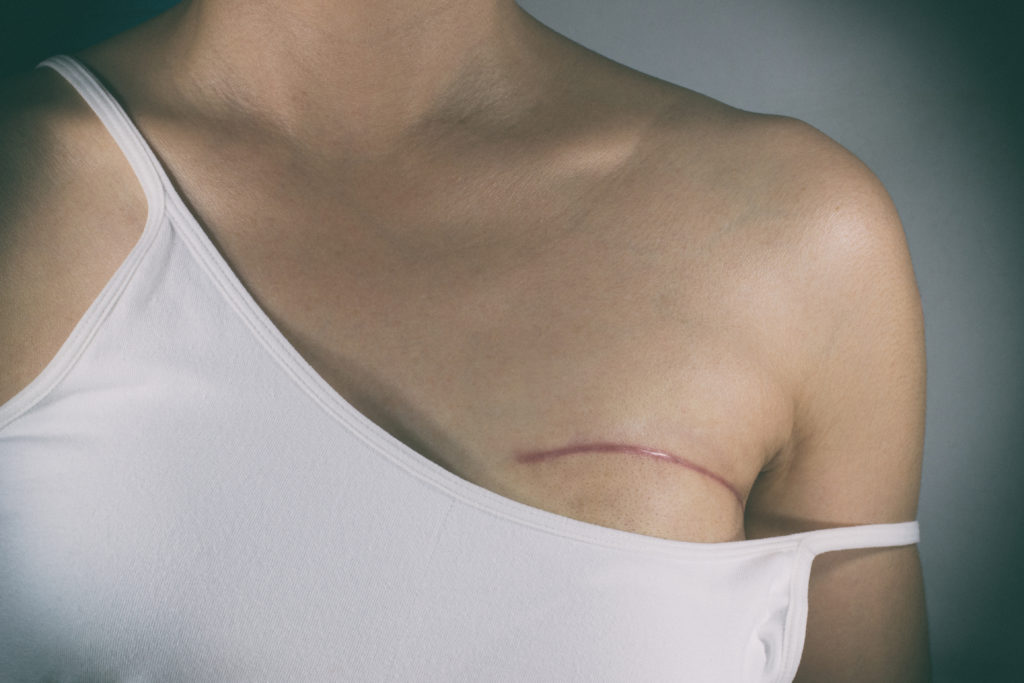Most cases of breast cancer are treated in multiple ways, a combination of treatments that depend on what stage your cancer is in, what type of cancer you have (such as triple-negative), or current or previous health, such as pregnancy, age, family history, previous cancer, or BRCA gene mutation. Here’s a breakdown of the most common types of breast cancer treatments.

Breast Surgery
Almost all breast cancer patients receive some form of breast surgery as part of their treatment. In the case of very early stages of breast cancer, some women can be treated with only a mastectomy, the removal of an entire breast (including the breast tissue). For most patients, however, surgery is done before other treatments to remove the tumor (lumpectomy), entire breast (mastectomy), both breasts (double mastectomy), or the lymph nodes (lymph node surgery).
Many women choose to have breast reconstruction surgery after their cancer has been treated. Those who have many risk factors for breast cancer, such as a strong family history or a gene mutation, may choose to have a prophylactic mastectomy, before they are even diagnosed, to reduce breast cancer risk.
Less Stress for Women Who Know Their Genetic Risk for Breast Cancer
Hormone Therapy
Like breast surgery, hormone therapy is prescribed in conjunction with other treatments. It can be used to prevent cancer, used before surgery (neoadjuvant therapy) or after surgery (adjuvant therapy) to keep the cancer from returning, or used as treatment if the cancer has come back or spread. These drugs are given in either pill or shot form. Most treatment courses last 5 years.
Hormone therapy treats cancers that are hormone-receptor-positive, meaning the tumors have proteins (receptors) that accept the estrogen or progesterone hormone. Cancers such as triple-negative breast cancer, more common in Black women and younger women, cannot be treated with hormone therapy.
Immunotherapy
Our immune systems not only fight viruses, bacteria, and fungi, naturally, but cancer growth, too. Unknown to us, our bodies likely reduce or prevent the growth of cancer in many cases. Immunotherapy treatment further boosts our immune systems to fight a variety of diseases and conditions such as allergies, Chron’s disease, multiple sclerosis, asthma, and cancer.
This type of treatment is most often used to treat triple-negative breast cancer, in conjunction with chemotherapy for patients whose cancer has recurred, are in stages 2-3 before or after surgery, or for patients whose cancer has spread.
Chemotherapy
Chemotherapy is a “systemic” treatment, meaning it attacks the entire body’s system, not just the cancer cells. It can be used before other treatments (neoadjuvant therapy) to help reduce the size the tumor or the speed it grows, after surgery (adjuvant therapy) to reduce the risk of cancer recurrence or destroy any remaining cancer, or as a way to improve quality of life rather than cure cancer (palliative therapy).
How A Patient Navigator Can Improve Cancer Treatment & Empower Patients
Most breast cancer patients receive chemotherapy at some point in their treatment. For those with triple-negative breast cancer, it is one of the few treatment options available. Chemotherapy should not be given to pregnant women in their first trimester and new mothers should not breastfeed while receiving chemotherapy treatment. Additionally, some postmenopausal women with certain types of breast cancer do not benefit from chemo.
Radiation Therapy
Radiation treatment, also known as radiotherapy or radiation, is a “local” therapy (rather than systemic), using x-ray radiation to disrupt cell growth of cancer tumors in a specific location. In external beam radiation, x-ray beams can be directed at the whole breast, one part of the breast, the lymph nodes, or chest wall, depending on where the cancer was found and what other treatment is prescribed. Internal beam radiation treatment, called brachytherapy, places radioactive pellets inside the body to deliver the radiation over time.
Radiation therapy is used to treat inflammatory breast cancer, after surgery (mastectomy or breast-conserving surgery) to reduce the risk of cancer recurrence, or for patients whose cancer has spread outside the breast.
Get our “Thriver Thursdays” Email
Get all the latest cancer prevention and treatment news plus upcoming survivor programs, straight to your inbox every Thursday. Your privacy is important to us.
Remember, no matter your treatment program, it’s important to follow the full course of drugs and procedures. A 2016 study published in the Journal of Clinical Oncology, for example, showed that not sticking to a prescribed hormone therapy program was associated with an increased rate of breast cancer recurrence.
Have concerns about your breast cancer treatment options or need help with insurance or payments? We are is here for you! SHAREing & CAREing is a New York-based non-profit founded and run by breast cancer survivors. Contact us for individual support, attend a monthly support group meeting or join our online Facebook group. We can help with free patient navigation services, links to free and reduced cost medical care, transportation assistance, and educational prevention workshops offered to schools and the community.
Sources
- Radiation For Breast Cancer, American Cancer Society
